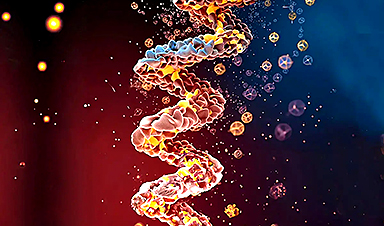MIT researchers develop “FrameDiff,” a computational tool that uses generative AI to craft new protein structures, with the aim of accelerating drug development and improving gene therapy.
MIT’s CSAIL researchers have developed a computational tool, FrameDiff, which employs generative AI to create new protein structures. It uses machine learning to model protein “backbones” and adjust them in 3D, crafting proteins beyond known designs. This breakthrough could accelerate drug development and enhance gene therapy by creating proteins that bind more efficiently, with potential applications in biotechnology, targeted drug delivery, and more.
Biology is a wondrous yet delicate tapestry. At the heart is DNA, the master weaver that encodes proteins, responsible for orchestrating the many biological functions that sustain life within the human body. However, our body is akin to a finely tuned instrument, susceptible to losing its harmony. After all, we’re faced with an ever-changing and relentless natural world: pathogens, viruses, diseases, and cancer.
To advance our capabilities in protein engineering, MIT CSAIL researchers came up with “FrameDiff,” a computational tool for creating new protein structures beyond what nature has produced. The machine learning approach generates “frames” that align with the inherent properties of protein structures, enabling it to construct novel proteins independently of preexisting designs, facilitating unprecedented protein structures.
“In nature, protein design is a slow-burning process that takes millions of years. Our technique aims to provide an answer to tackling human-made problems that evolve much faster than nature’s pace,” says MIT CSAIL PhD student Jason Yim, a lead author on a new paper about the work. “The aim, with respect to this new capacity of generating synthetic protein structures, opens up a myriad of enhanced capabilities, such as better binders. This means engineering proteins that can attach to other molecules more efficiently and selectively, with widespread implications related to targeted drug delivery and biotechnology, where it could result in the development of better biosensors. It could also have implications for the field of biomedicine and beyond, offering possibilities such as developing more efficient photosynthesis proteins, creating more effective antibodies, and engineering nanoparticles for gene therapy.”
Framing FrameDiff
Proteins have complex structures, made up of many atoms connected by chemical bonds. The most important atoms that determine the protein’s 3D shape are called the “backbone,” kind of like the spine of the protein. Every triplet of atoms along the backbone shares the same pattern of bonds and atom types. Researchers noticed this pattern can be exploited to build machine learning algorithms using ideas from differential geometry and probability. This is where the frames come in: Mathematically, these triplets can be modeled as rigid bodies called “frames” (common in physics) that have a position and rotation in 3D.

Generation of a protein structure with FrameDiff. Credit: Ian Haydon/Institute for Protein Design
These frames equip each triplet with enough information to know about its spatial surroundings. The task is then for a machine learning algorithm to learn how to move each frame to construct a protein backbone. By learning to construct existing proteins, the algorithm hopefully will generalize and be able to create new proteins never seen before in nature.
Training a model to construct proteins via “diffusion” involves injecting noise that randomly moves all the frames and blurs what the original protein looked like. The algorithm’s job is to move and rotate each frame until it looks like the original protein. Though simple, the development of diffusion on frames requires techniques in stochastic calculus on Riemannian manifolds. On the theory side, the researchers developed “SE(3) diffusion” for learning probability distributions that nontrivially connects the translations and rotations components of each frame.
The subtle art of diffusion
In 2021, DeepMind introduced AlphaFold2, a deep learning algorithm for predicting 3D protein structures from their sequences. When creating synthetic proteins, there are two essential steps: generation and prediction. Generation means the creation of new protein structures and sequences, while “prediction” means figuring out what the 3D structure of a sequence is. It’s no coincidence that AlphaFold2 also used frames to model proteins. SE(3) diffusion and FrameDiff were inspired to take the idea of frames further by incorporating frames into diffusion models, a generative AI technique that has become immensely popular in image generation, like Midjourney, for example.
The shared frames and principles between protein structure generation and prediction meant the best models from both ends were compatible. In collaboration with the Institute for Protein Design at the University of Washington, SE(3) diffusion is already being used to create and experimentally validate novel proteins. Specifically, they combined SE(3) diffusion with RosettaFold2, a protein structure prediction tool much like AlphaFold2, which led to “RFdiffusion.” This new tool brought protein designers closer to solving crucial problems in biotechnology, including the development of highly specific protein binders for accelerated vaccine design, engineering of symmetric proteins for gene delivery, and robust motif scaffolding for precise enzyme design.
Future endeavors for FrameDiff involve improving generality to problems that combine multiple requirements for biologics such as drugs. Another extension is to generalize the models to all biological modalities including DNA and small molecules. The team posits that by expanding FrameDiff’s training on more substantial data and enhancing its optimization process, it could generate foundational structures boasting design capabilities on par with RFdiffusion, all while preserving the inherent simplicity of FrameDiff.
“Discarding a pretrained structure prediction model [in FrameDiff] opens up possibilities for rapidly generating structures extending to large lengths,” says Harvard University computational biologist Sergey Ovchinnikov. The researchers’ innovative approach offers a promising step toward overcoming the limitations of current structure prediction models. Even though it’s still preliminary work, it’s an encouraging stride in the right direction. As such, the vision of protein design, playing a pivotal role in addressing humanity’s most pressing challenges, seems increasingly within reach, thanks to the pioneering work of this MIT research team.”
Yim wrote the paper alongside Columbia University postdoc Brian Trippe, French National Center for Scientific Research in Paris’ Center for Science of Data researcher Valentin De Bortoli, Cambridge University postdoc Emile Mathieu, and Oxford University professor of statistics and senior research scientist at DeepMind Arnaud Doucet. MIT professors Regina Barzilay and Tommi Jaakkola advised the research.
The team’s work was supported, in part, by the MIT Abdul Latif Jameel Clinic for Machine Learning in Health, EPSRC grants and a Prosperity Partnership between Microsoft Research and Cambridge University, the National Science Foundation Graduate Research Fellowship Program, NSF Expeditions grant, Machine Learning for Pharmaceutical Discovery and Synthesis consortium, the DTRA Discovery of Medical Countermeasures Against New and Emerging threats program, the DARPA Accelerated Molecular Discovery program, and the Sanofi Computational Antibody Design grant. This research will be presented at the International Conference on Machine Learning in July.
News
Nano-Enhanced Hydrogel Strategies for Cartilage Repair
A recent article in Engineering describes the development of a protein-based nanocomposite hydrogel designed to deliver two therapeutic agents—dexamethasone (Dex) and kartogenin (KGN)—to support cartilage repair. The hydrogel is engineered to modulate immune responses and promote [...]
New Cancer Drug Blocks Tumors Without Debilitating Side Effects
A new drug targets RAS-PI3Kα pathways without harmful side effects. It was developed using high-performance computing and AI. A new cancer drug candidate, developed through a collaboration between Lawrence Livermore National Laboratory (LLNL), BridgeBio Oncology [...]
Scientists Are Pretty Close to Replicating the First Thing That Ever Lived
For 400 million years, a leading hypothesis claims, Earth was an “RNA World,” meaning that life must’ve first replicated from RNA before the arrival of proteins and DNA. Unfortunately, scientists have failed to find [...]
Why ‘Peniaphobia’ Is Exploding Among Young People (And Why We Should Be Concerned)
An insidious illness is taking hold among a growing proportion of young people. Little known to the general public, peniaphobia—the fear of becoming poor—is gaining ground among teens and young adults. Discover the causes [...]
Team finds flawed data in recent study relevant to coronavirus antiviral development
The COVID pandemic illustrated how urgently we need antiviral medications capable of treating coronavirus infections. To aid this effort, researchers quickly homed in on part of SARS-CoV-2's molecular structure known as the NiRAN domain—an [...]
Drug-Coated Neural Implants Reduce Immune Rejection
Summary: A new study shows that coating neural prosthetic implants with the anti-inflammatory drug dexamethasone helps reduce the body’s immune response and scar tissue formation. This strategy enhances the long-term performance and stability of electrodes [...]
Scientists discover cancer-fighting bacteria that ‘soak up’ forever chemicals in the body
A family of healthy bacteria may help 'soak up' toxic forever chemicals in the body, warding off their cancerous effects. Forever chemicals, also known as PFAS (per- and polyfluoroalkyl substances), are toxic chemicals that [...]
Johns Hopkins Researchers Uncover a New Way To Kill Cancer Cells
A new study reveals that blocking ribosomal RNA production rewires cancer cell behavior and could help treat genetically unstable tumors. Researchers at the Johns Hopkins Kimmel Cancer Center and the Department of Radiation Oncology and Molecular [...]
AI matches doctors in mapping lung tumors for radiation therapy
In radiation therapy, precision can save lives. Oncologists must carefully map the size and location of a tumor before delivering high-dose radiation to destroy cancer cells while sparing healthy tissue. But this process, called [...]
Scientists Finally “See” Key Protein That Controls Inflammation
Researchers used advanced microscopy to uncover important protein structures. For the first time, two important protein structures in the human body are being visualized, thanks in part to cutting-edge technology at the University of [...]
AI tool detects 9 types of dementia from a single brain scan
Mayo Clinic researchers have developed a new artificial intelligence (AI) tool that helps clinicians identify brain activity patterns linked to nine types of dementia, including Alzheimer's disease, using a single, widely available scan—a transformative [...]
Is plastic packaging putting more than just food on your plate?
New research reveals that common food packaging and utensils can shed microscopic plastics into our food, prompting urgent calls for stricter testing and updated regulations to protect public health. Beyond microplastics: The analysis intentionally [...]
Aging Spreads Through the Bloodstream
Summary: New research reveals that aging isn’t just a local cellular process—it can spread throughout the body via the bloodstream. A redox-sensitive protein called ReHMGB1, secreted by senescent cells, was found to trigger aging features [...]
AI and nanomedicine find rare biomarkers for prostrate cancer and atherosclerosis
Imagine a stadium packed with 75,000 fans, all wearing green and white jerseys—except one person in a solid green shirt. Finding that person would be tough. That's how hard it is for scientists to [...]
Are Pesticides Breeding the Next Pandemic? Experts Warn of Fungal Superbugs
Fungicides used in agriculture have been linked to an increase in resistance to antifungal drugs in both humans and animals. Fungal infections are on the rise, and two UC Davis infectious disease experts, Dr. George Thompson [...]
Scientists Crack the 500-Million-Year-Old Code That Controls Your Immune System
A collaborative team from Penn Medicine and Penn Engineering has uncovered the mathematical principles behind a 500-million-year-old protein network that determines whether foreign materials are recognized as friend or foe. How does your body [...]





















